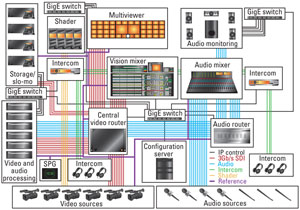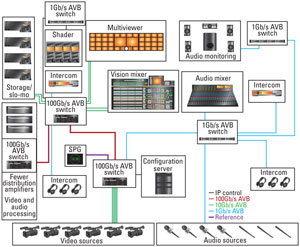The rise of AVB
Chances are you’ve heard of audio/video bridging (AVB). Chances are even better you don’t really know what it is. Read on, because AVB technology offers some real advantages over SDI, the kind of benefits that mesh with the new IT-driven video landscape.
The professional media transport market is still dominated by point-to-point analog wiring systems. (See Figure 1.) But there is an explosion of digital networks steadily replacing analog cabling and point-to-point digital cables for more scalable, flexible and high-performance AV systems. The dominance of digital signal processing, continual improvement in the price and performance of networking technologies, widespread deployment of IT networks and the increasing use of computer equipment for playback, storage, and processing of media signals are all driving digital adoption. Now that AV equipment can be networked without sacrificing performance, the AV and IT industries are converging, enabling new AV applications and collaborative, networked systems.

Figure 1. SDI-based facilities often end up with massive star-shaped architectures.
Yet, for all of its promise, conventional IT networking has lacked the precise timing needed by the professional broadcast environment. AVB’s primary drive is to add the timing precision so professionals can rely on traditional performance from inexpensive, off-the-shelf network fabrics. The IT industry has, in a sense, caught up, delivering the speed and reliability demanded by broadcasters and content providers.
Infrastructure
AVB, an open standard established by the IEEE, is a group of network protocols for the distribution of time-synchronized, low-latency audio and video streams over Ethernet. All audio and video streams, as well as associated control, metadata and synchronization needed for a live production, are on a single cable/layer — one connection that works as both an input and output.
The highly scalable IT-based system enables the use of current as well as new standards, such as 4K, with standard, off-the-shelf switches with software on top, providing broadcasters with predictable, reliable, consistent and uncompressed video delivery. The system is synchronous on top of a asynchronous network. What you put in is what you get out for stable, fast, low-latency transport with an overall network delay of 2ms.
The professional video industry's #1 source for news, trends and product and tech information. Sign up below.
AVB technology lays the foundation for high-quality, low-latency guaranteed media streaming over Ethernet networks. The three core protocols allow for timing and synchronization, bandwidth allocation through the stream reservation protocol (SRP) and traffic shaping to ensure that low-priority Ethernet traffic does not interfere with critical AVB video traffic. AVB devices also periodically exchange timing information so both ends of the link synchronize their time base reference clocks precisely for synchronization of multiple streams.
Advantages
Today’s Ethernet devices predominantly support full-duplex operation at 100Mb/s or greater. Since the total available bandwidth available over such an Ethernet link is both known and constant, an AVB reservation over those Ethernet links combined with the appropriate traffic shaping assures both throughput and delivery latency parameters are met for packets of reserved streams. AVB devices are able to reserve a portion of network resources through the use of admission control and traffic shaping and send and receive the new timing-based frames.
Historically, increases in cost-effective bandwidth have enabled new network services. In the case of AV systems, the shift to gigabit networking creates the necessary bandwidth for truly high-performance AV networking systems. Increased bandwidth improves every aspect of AV networking systems, lowering latency, increasing channel capacity or quality, and improving synchronization.
The key advantages of AVB networking are:
- Simple, single-layer infrastructure;
- Completely synchronous, stable, fast and low-latency transport;
- Co-existence with legacy systems;
- Traffic shaping and prioritization, ensuring no media bursts;
- Bandwidth allocation through the stream reservation protocol (SRP);
- Economies of scale.
In addition to the continuing standardization work of the IEEE, an industry body, the AVnu Alliance, is working to advance AVB and its standardization. Its remit: to create compliance test procedures and processes that ensure the interoperability of networked A/V devices and the highest quality streaming A/V experience, as well as AVB applications in automotive, professional and consumer electronics markets.
The production facility of the future
Sometime in the not-so-distant future, production studios will likely be constructed with far less wiring and a lot more efficiency. With AVB, the design and build of a broadcast facility suddenly becomes much easier, more flexible and less costly. (See Figure 2.) Removing the inherent bandwidth, speed and set-up problems of single-wire SDI infrastructure, AVB provides agile, easy and instantly connected network access. At a glance, it avoids the old connection model that results in massive star-shaped architectures and muddled masses of cables.

Figure 2. An AVB-based facility is simpler, with far fewer cables.
While greenfield deployment of AVB equipment will be straightforward, networks with one or more islands of AVB connectivity might need to be more carefully considered, at least for the short to medium term.
Next-generation media networks
AVB is engineered from the ground up for media streaming applications, providing an edge over legacy Ethernet technology due to its bandwidth allocation and priority rules based on timing. And like all Ethernet-based technologies, seamless end-to-end management of AVB networks is critical to successful operations. With sophisticated software, providers are able to integrate full monitoring and management functionality while hiding any underlying complexity.
In time, the interoperability of AVB switches and endpoints will be expanded and will drive the penetration of digital AV networked devices. As the professional broadcast community is educated about what AVB can achieve and how, AVB standards will be finalized and compliance certification processes completed. A transition period is sure to follow until AVB switches are prevalent and OEM AV manufacturers develop new products incorporating compliant versions of AVB. It won’t be one infrastructure or one networking provider that dominates the market. Many organizations across regions will need to embrace the technology to advance its adoption and speed creation of AVB devices, equipment and applications.
It will undoubtedly take time for the industry to adopt AVB. Professional content providers won’t abandon tried-and-true SDI applications overnight, but AVB is here, and it can be deployed alongside existing legacy infrastructures. It’s making noise and warrants a close look.
— Jan Eveleens is CEO of Axon.
